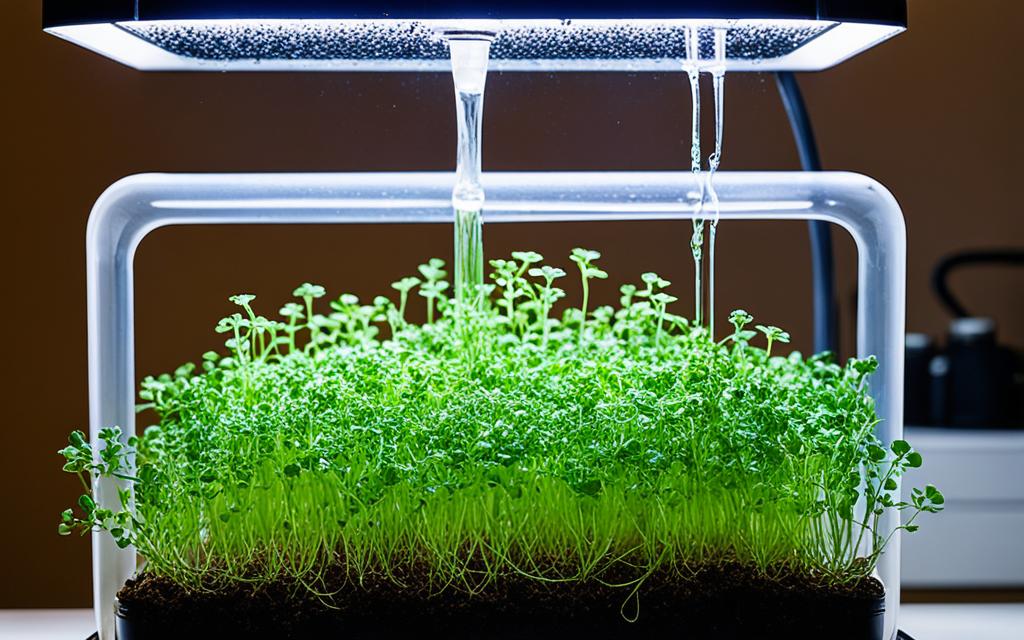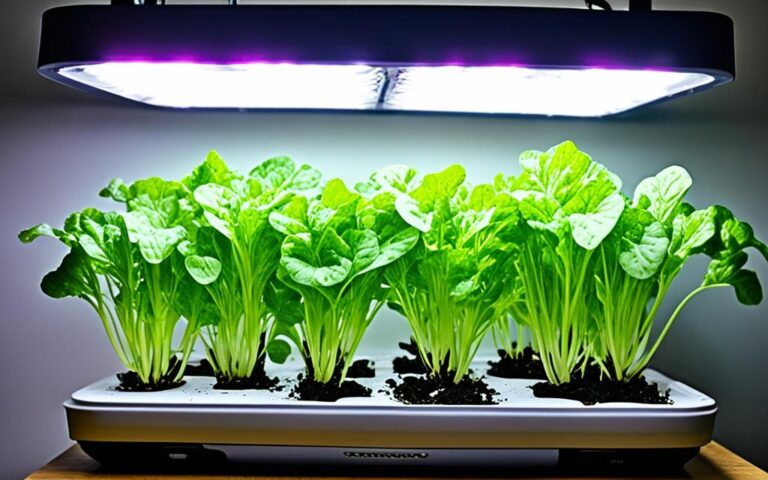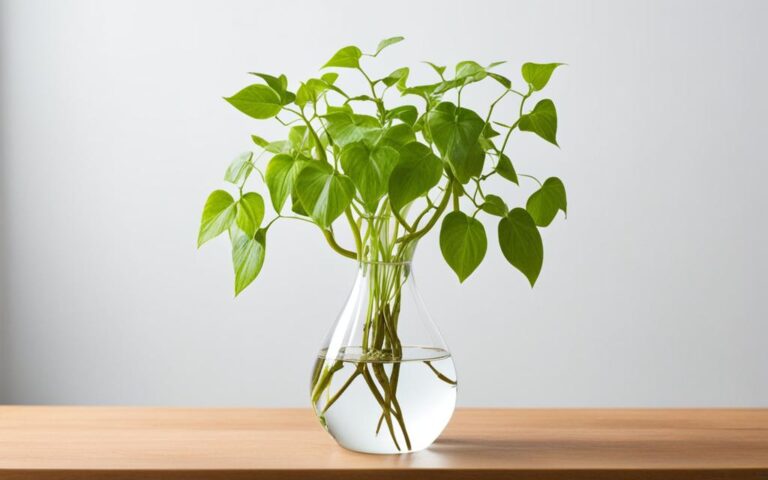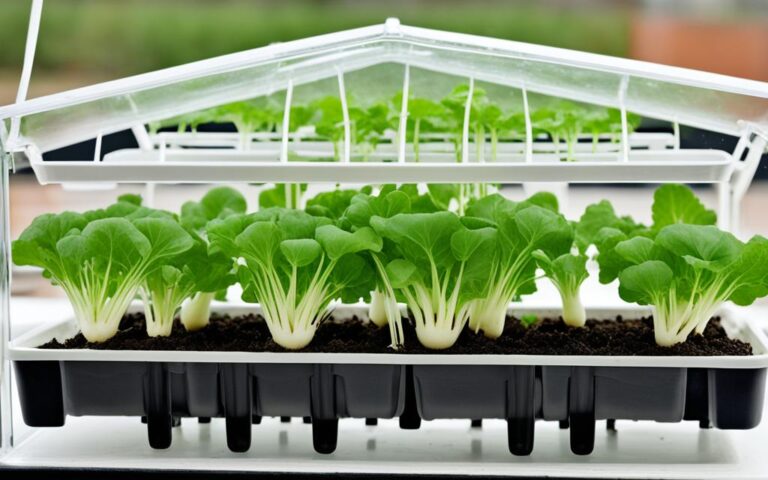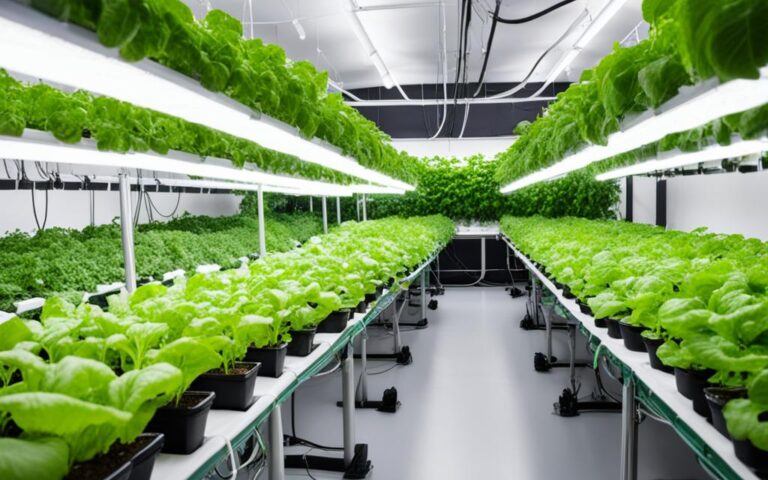Hydroponic Thyme Growth Guide – Tips & Tricks
Did you know the global hydroponic market is set to hit $27.2 billion by 2027? This growth is thanks to the increasing need for sustainable, soil-free ways to grow herbs like thyme. Hydroponic thyme lets you enjoy fresh herbs all year, even in small indoor spaces.
This guide will give you expert advice on growing hydroponic thyme. You’ll learn about choosing the best variety, managing nutrients, lighting, and controlling pests and diseases. It’s perfect for both experienced indoor gardeners and beginners in soilless gardening. You’ll get all the info you need to grow delicious thyme with modern hydroponic systems.
Key Takeaways
- Hydroponic thyme offers a sustainable and space-efficient way to grow fresh herbs year-round
- Selecting the right thyme variety, such as Common Thyme or Lemon Thyme, is crucial for optimal growth
- Proper seed germination, nutrient solution management, and lighting are essential for thriving hydroponic thyme
- Hydroponic systems like Nutrient Film Technique (NFT) and Deep Water Culture (DWC) are well-suited for growing thyme
- Pruning and harvesting techniques ensure a continuous supply of flavorful thyme leaves
Introduction to Hydroponic Thyme Cultivation
Growing hydroponic thyme has many benefits over traditional soil methods. It uses soilless techniques to give thyme plants the best conditions for growth. This leads to faster growth, more yields, and more phytochemicals.
Indoor herb gardening with hydroponic thyme lets you control the plant’s environment. You can adjust nutrients, pH, temperature, and lighting easily. This ensures thyme plants grow well and reach their best potential.
Soilless cultivation also means no pests or diseases from the soil. It cuts down on the use of harsh chemicals, making it better for the planet. This leads to a better quality and tastier hydroponic herbs harvest.
| Benefits of Hydroponic Thyme Cultivation | Advantages |
|---|---|
| Precise control over growing conditions | Optimal nutrient levels, pH, temperature, and lighting |
| Elimination of soil-borne pests and diseases | Reduced need for harsh chemicals, more sustainable growing |
| Increased yields and quality | Higher concentrations of beneficial compounds like thymol and carvacrol |
This guide will cover the best ways to grow hydroponic thyme plants. From starting with seeds to pruning and harvesting, we’ll go through it all. By following these steps, you can have a successful and tasty indoor herb gardening experience.
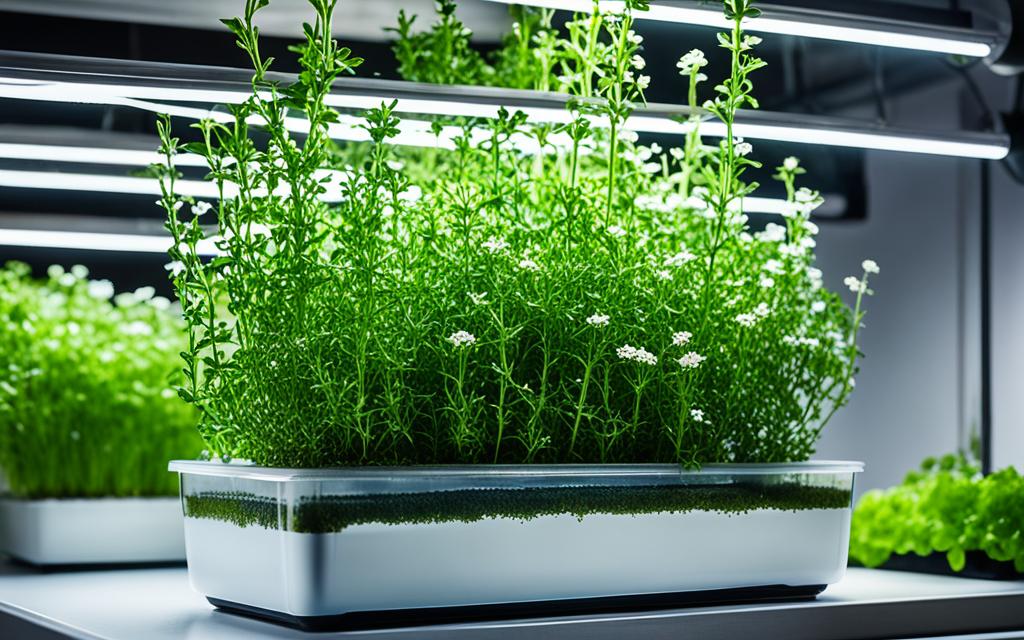
Selecting the Right Thyme Variety
Choosing the right thyme variety is key for a successful hydroponic garden. Popular choices include common thyme (Thymus vulgaris), lemon thyme (Thymus citriodorus), and Yunnan thyme (Thymus mongolicus). Each type has its own taste and growth habits. Think about what you like to cook and the conditions of your garden when picking.
Common Thyme (Thymus vulgaris)
Thymus vulgaris, or common thyme, is a favorite for many. It has a strong, earthy taste with notes of pine and mint. This variety is tough, grows compact, and does well in hydroponics, fitting a variety of conditions.
Lemon Thyme (Thymus citriodorus)
Thymus citriodorus, or lemon thyme, is loved for its citrusy scent and taste. It brings a fresh, zesty touch to dishes. Though a bit more delicate, lemon thyme can flourish in hydroponics with the right care.
Yunnan Thyme (Thymus mongolicus)
Thymus mongolicus, or Yunnan thyme, comes from China’s Yunnan province. It has a strong, peppery taste with hints of flowers. This variety is tough, can handle drought, and is great for hydroponics, perfect for those with experience.
“The right thyme variety can make all the difference in your hydroponic thyme harvest.”
Germinating Thyme Seeds
Starting with thyme seed germination is crucial for growing hydroponic thyme seedlings. Begin by soaking the thyme seeds in water for 6-12 hours. This makes the seeds ready for growth.
Seed Preparation and Sowing
After soaking, spread the thyme seeds over a hydroponic medium. Press them gently into the surface. This helps them grow well.
Optimal Germination Conditions
- Provide thyme seeds with moderate light levels
- Keep the thyme seed sowing area moist
- Keep the temperature at 65-70°F for thyme seed germination
With patience and the right conditions, thyme seeds will germinate in 7-21 days. Then, move the hydroponic thyme seedlings to your preferred setup.
| Germination Factor | Optimal Range |
|---|---|
| Temperature | 65-70°F |
| Moisture | Consistent |
| Light | Moderate |
| Germination Time | 7-21 days |
“Patience and attention to detail are key for successful thyme seed germination and the establishment of healthy hydroponic thyme seedlings.”
Transferring Seedlings to Hydroponic System
When your hydroponic thyme seedlings grow their first true leaves and strong roots, they’re ready for the next step, usually after 2-3 weeks. Make sure your thyme hydroponic system is set up right. This means having the right water quality, pH, nutrient solution, and environment for growth.
When moving the seedlings, be gentle with their roots and watch how they adjust to their new home. This step is key for a successful hydroponic thyme harvest.
Prepare the Hydroponic System
Before moving the thyme seedlings, get your hydroponic system ready. This means:
- Ensuring the water quality meets the thyme’s needs
- Adjusting the pH to the best range for thyme
- Mixing the right nutrient solution with the correct EC value
- Providing the right lighting and temperature for thyme growth
Transplant the Seedlings
Here’s how to move the hydroponic thyme seedlings:
- Take the seedlings out of their starter containers carefully to avoid harming the roots.
- Put the seedlings in the hydroponic grow medium, leaving enough space for growth.
- Make sure the seedlings are securely rooted in the system.
- Keep an eye on the seedlings for a few days and adjust their environment as needed for a smooth transition.
By getting your hydroponic system ready and transplanting the thyme seedlings with care, you’re on your way to a great hydroponic thyme harvest.
Water Quality and pH Levels
For growing healthy hydroponic thyme, it’s key to keep the water quality and pH levels right. The hydroponic thyme water quality and thyme pH range affect how well your plants absorb nutrients and stay healthy.
Importance of Pure Water
Using pure, distilled, or deionized water is a must for hydroponic thyme. Tap water can have contaminants and minerals that harm the pure water for thyme needs. This can cause problems like nutrient imbalances or pH changes.
Maintaining Optimal pH Range
The best thyme pH range for hydroponics is between 5.5 and 6.5. This range helps plants get the nutrients they need to grow well. To keep the hydroponic thyme pH right, test the water often with a pH kit. Then, add acid or base to adjust the levels as needed.
| Parameter | Optimal Range |
|---|---|
| pH | 5.5 – 6.5 |
| EC (Electrical Conductivity) | 1.2 – 2.0 mS/cm |
| Temperature | 18 – 24°C (64 – 75°F) |
| Dissolved Oxygen | > 6 ppm |
By keeping the hydroponic thyme water quality and thyme pH range in check, you help your plants grow strong and healthy.
Nutrient Solution and EC Value
For hydroponic thyme plants to thrive, it’s important to balance their nutrients carefully. Thyme needs specific elements for healthy growth and development. These include nitrogen for leaves, phosphorus for roots and flowers, and potassium for stress and water balance.
Thyme also gets benefits from calcium, magnesium, sulfur, and many micronutrients like iron, zinc, and manganese. Keeping an eye on the electrical conductivity (EC) of the nutrient solution is key. This ensures your plants get the right amount of nutrients.
Essential Nutrients for Thyme
- Nitrogen (N) for leaf and stem growth
- Phosphorus (P) for root development and flowering
- Potassium (K) for stress resistance and water regulation
- Calcium (Ca), Magnesium (Mg), and Sulfur (S)
- Micronutrients like Iron (Fe), Zinc (Zn), and Manganese (Mn)
Monitoring and Adjusting EC Value
Keep the thyme EC value between 1.2-1.8 mS/cm in your hydroponic setup. Check the EC level often and adjust it if needed. This ensures your thyme gets the right nutrients for strong growth and plenty of production.
Lighting Requirements
Proper lighting is key for your hydroponic thyme plants to grow well. They need light that’s strong, between 10,000 to 15,000 lux per square meter. For indoor setups, use grow lights that give off red and blue light, like natural sunlight.
Place your grow lights so your thyme gets 12-14 hours of light daily. Change the light time if needed to help your thyme grow strong and taste great. Consistent and right lighting is crucial for healthy hydroponic thyme.
| Lighting Requirement | Recommendation |
|---|---|
| Light Intensity | 10,000 – 15,000 lux per square meter |
| Spectrum | Red and blue light |
| Photoperiod | 12-14 hours per day |
By following the hydroponic thyme lighting needs, you’ll grow healthy, tasty indoor thyme grow lights in your hydroponic setup.
“Proper lighting is the foundation for a thriving hydroponic thyme crop.”
Temperature and Humidity Control
Keeping the right temperature and humidity is key for growing hydroponic thyme. The best hydroponic thyme temperature is between 65-70°F. Make sure your plants stay in this range, adjusting as needed for seasonal changes.
Thyme likes a low thyme humidity requirements. So, keep the air moving well to avoid mold or fungal diseases.
By controlling these factors, you make the best optimal thyme growing conditions for your plants. Getting the temperature and humidity right helps with healthy growth, great flavor, and a strong scent in your thyme.
“Precise temperature and humidity control are the foundations of a thriving hydroponic thyme garden.”
- Keep the temperature between 65-70°F for the best thyme growth.
- Make sure there’s good air flow and ventilation to keep humidity low.
- Watch and adjust the environment as needed for the perfect conditions.
By managing the hydroponic thyme temperature and thyme humidity requirements well, you’ll get the most out of your hydroponic thyme. Enjoy a rich, tasty harvest.
Hydroponic Systems for Thyme
There are several hydroponic systems that work well for growing thyme. The Nutrient Film Technique (NFT) and Deep Water Culture (DWC) are two popular ones. Each system has its own benefits and things to consider for thyme growers.
Nutrient Film Technique (NFT)
The Nutrient Film Technique (NFT) keeps a steady flow of nutrient-rich water over the roots. This ensures thyme plants get the nutrients they need for strong growth and healthy leaves. The moving water also stops water from standing still and keeps the roots well-oxygenated.
Deep Water Culture (DWC)
In a Deep Water Culture (DWC) system, thyme roots hang in an oxygen-rich nutrient solution. This setup gives roots lots of nutrients and oxygen, helping them grow well. DWC is known for being simple and easy to keep up.
When picking the best hydroponic system for thyme, think about what your plants need, the space you have, and your hydroponic gardening experience. Both NFT and DWC are good for growing hydroponic thyme. Choose the system that fits your goals and setup best.
“Hydroponic systems provide an optimal environment for thyme cultivation, allowing growers to precisely control the plant’s access to nutrients, water, and oxygen.”
| Hydroponic System | Key Benefits | Considerations |
|---|---|---|
| Nutrient Film Technique (NFT) |
|
|
| Deep Water Culture (DWC) |
|
|
hydroponic Thyme
For gardeners looking for a thriving and sustainable herb, growing hydroponic thyme is a great choice. It offers many benefits over traditional soil methods. These include faster growth, more produce, and higher levels of good compounds.
By using soilless methods, you give thyme plants the perfect conditions to grow. This lets you control their nutrients, water, and environment. This results in a healthy and abundant harvest.
To succeed with thyme hydroponics, know what this herb needs. Pick the right thyme type, manage the nutrients well, and control the environment. Each step is key to getting the most from your hydroponic thyme garden.
Choosing the Right Thyme Variety
When starting with hydroponic thyme, pick a type that fits your goals and tastes. Popular choices include:
- Common Thyme (Thymus vulgaris): Known for its strong flavor and smell, it’s versatile.
- Lemon Thyme (Thymus citriodorus): Adds a citrus twist, great for cooking and scents.
- Yunnan Thyme (Thymus mongolicus): Tough and can handle heat, grows well in many conditions.
Think about each thyme type’s traits and how they fit your hydroponic setup and herb use.
“Hydroponic thyme cultivation allows me to enjoy a consistent, high-quality harvest year-round, regardless of the outdoor conditions. It’s a game-changer for my culinary endeavors!”
– Jane Doe, Avid Home Chef and Gardener
Pruning and Harvesting
Keeping a hydroponic thyme garden healthy means pruning and harvesting regularly. Pruning keeps your thyme plants looking good and growing well. When pruning hydroponic thyme, cut off dead or yellowed leaves just above where two leaves meet. This encourages new growth and stops the thyme from getting woody.
Proper Pruning Techniques
For effective thyme pruning, use clean, sharp scissors or shears. Don’t tear the leaves as it can hurt the plant. When trimming, think about the plant’s shape and cut evenly to keep it looking full and neat.
Harvesting Fresh Thyme
When it’s time to harvest hydroponic thyme, use clean tools to cut the stems, leaving enough for the plant to regrow. Harvest the thyme just before it flowers, when the leaves are at their best. This way, you get the full flavor and smell of the herb. Good thyme harvesting practices mean you always have fresh thyme for cooking.
“Regular pruning and harvesting are essential to maintain the health and productivity of your hydroponic thyme plants.”
Common Pests and Diseases
Keeping a hydroponic thyme garden healthy means watching out for pests and diseases. This herb is tough, but it can still face problems if we don’t take care.
Aphids are a big problem for hydroponic thyme. These tiny bugs suck the sap, slowing growth and changing the plant’s color. To fight aphids, we can remove them by hand, use ladybugs, or spray with organic insect killers.
Spider mites are another issue. They eat the leaves, making them look stippled or off-color. To stop them, we mist the plants and use predatory mites.
Powdery mildew is a fungal disease that can hit hydroponic thyme. It looks like a white powder on the leaves and stems. To avoid it, keep the air moving, control humidity, and use organic fungicides.
Gray mold, or Botrytis, is a fungal disease that likes cool, damp places. It can rot leaves, stems, and even the whole plant. To prevent gray mold, improve air flow, lower humidity, and use fungicides.
To handle pests and diseases in hydroponic thyme, we need a good thyme pest control and thyme disease management plan. This means:
- Checking plants often for problems
- Removing pests by hand
- Adding beneficial insects and organisms
- Using organic pesticides and fungicides when needed
- Keeping growing conditions just right to prevent problems
By being careful and acting fast, hydroponic thyme growers can keep their plants healthy and productive.
Companion Planting with Thyme
Thyme is a versatile herb that’s great for a hydroponic garden. It helps many other herbs and vegetables grow better. Adding thyme to your indoor garden makes it healthier and more productive.
Some plants that love being near thyme are cabbage, Brussels sprouts, kale, potatoes, tomatoes, broccoli, eggplants, and strawberries. Thyme’s strong smell keeps pests like aphids and whiteflies away. Its deep roots also make the soil better for other plants.
When picking thyme as a companion plant, think about what each plant needs. For example, tomatoes and eggplants like it warm, while kale and broccoli prefer cooler temperatures. Choosing the right plants together makes your hydroponic garden balanced and productive.
| Thyme Companion Plants | Benefits |
|---|---|
| Cabbage, Brussels sprouts, kale | Thyme’s strong aroma can help repel pests like cabbage worms and aphids. |
| Potatoes | Thyme can help improve soil structure and drainage, benefiting potato growth. |
| Tomatoes, eggplants | Thyme’s aromatic properties can help deter pests that may affect these plants. |
| Broccoli | Thyme’s deep roots can help loosen the soil, allowing for better nutrient and water absorption. |
| Strawberries | Thyme’s low-growing habit can help suppress weeds and retain soil moisture around strawberry plants. |
Using thyme as a companion plant in your hydroponic system makes your garden more diverse. It creates a thriving, balanced environment for your herbs and vegetables.
Thyme’s Culinary and Medicinal Uses
Thyme is a versatile herb with many uses in the kitchen and medicine. It’s a key ingredient in many dishes, adding a unique smell and taste.
In cooking, thyme is a must-have. It’s used to season meats, fish, veggies, soups, and stews. It adds a rich, earthy flavor that goes well with many foods. Using hydroponic thyme in your cooking can make dishes taste fresh and vibrant.
Thyme is not just for cooking. It has thyme medicinal properties too. It fights inflammation, germs, and infection. It’s full of vitamins A and K, which are good for your health.
Whether you want to improve your cooking or find natural health remedies, using hydroponic thyme is a smart choice. This amazing herb can make your meals better and help you stay healthy.
“Thyme is the essence of simple pleasures, elevating even the most humble of dishes with its distinctive flavor and aroma.”
Conclusion
Growing thyme hydroponically is a rewarding way to have this aromatic herb indoors. This article gives you all you need to know to grow a thriving hydroponic thyme garden. You’ll learn how to pick the best variety, manage nutrients, lighting, and the environment. With patience and care, you’ll get to enjoy fresh, tasty thyme for your cooking and health.
Hydroponic thyme is versatile and can be used in many ways. This guide gives you the tools and knowledge to start or improve your indoor herb garden. Let’s explore the potential of hydroponic thyme, growing thyme hydroponically, and indoor herb gardening together.
With the techniques from this article, you’re set to enjoy the many benefits of fresh thyme. Start your journey and let your love for hydroponic thyme grow into a beautiful, sustainable, and tasty indoor herb garden.
